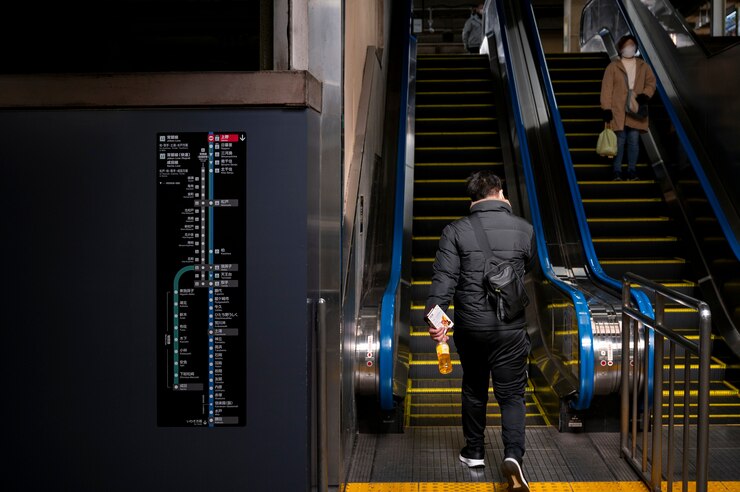TECHNOLOGY
Comprehensive Overview of Types of Electric Gates

Are you exploring options for electronic gates? Electric gates are an excellent addition to residential and commercial properties, offering enhanced security and convenience while increasing property value. These gates come in various styles and operating mechanisms, each suited to different needs and preferences. Understanding the various types of electric gates can help property owners make informed decisions when considering their installation. We will explore the main types of electric gates, including their mechanisms, suitable applications, and key considerations for installation.
Swinging Electric Gates
Swinging gates are among the most common electric gates in residential and commercial properties. They operate similarly to traditional hinged doors, swinging open and closed from a stationary hinge point on one side. These gates can be single or double-leaf, with double-leaf designs ideal for wider entrances. Swinging gates require sufficient space to operate freely, which is best suited for properties with ample driveway space to accommodate the gate’s arc when it opens or closes. It is important to consider the gate’s swing path when installing swinging gates to ensure it does not obstruct parking areas, landscaping, or pedestrian traffic.
Sliding Electric Gates
Sliding electric gates are an excellent choice for properties with limited space where a swinging gate’s arc would be impractical. These gates slide on a track parallel to the fence or wall. Sliding gates are particularly effective in tight spaces, including commercial environments or residential areas where driveway space is at a premium. They can be designed to slide in a single or telescopic manner, where multiple-gate panels overlap as they open and close, saving even more space. Installation of sliding gates typically involves laying a track that requires a level surface to ensure smooth operation and functionality.
Cantilever Electric Gates
Cantilever gates are a variant of the sliding gate but do not require a track along the driveway’s length. Instead, these gates are supported by rails running along the fence structure’s inside. The gate is free-hanging, allowing it to move back and forth without any friction on the ground, making it particularly suitable for areas where the driveway entrance may have uneven or rough terrain. Cantilever gates are generally more expensive than their tracked counterparts due to the complexity of their design and the heavier materials needed to ensure stability and smooth operation.
Bi-Folding Electric Gates
Bi-folding gates, also known as speed gates, are designed for quick operation, making them suitable for high-traffic areas such as commercial garages or business districts. These gates have two panels that fold back on themselves, allowing quicker and more compact opening and closing actions. This design is beneficial in areas where access speed is crucial, and space is too limited for sliding gates. Bi-folding gates require precise mechanical design to ensure they operate smoothly and reliably, often involving more complex installation and maintenance than simpler gate designs.
Underground Electric Gates
Underground electric gates offer an aesthetic solution where the gate operator and mechanism are concealed beneath the ground. This type of installation is most common with swinging gates and is favored for its minimal visual impact, preserving the property’s aesthetic appeal. The mechanism is housed in a robust casing below ground level at each gate pivot point. While underground systems are visually pleasing and unobtrusive, they can be more susceptible to water ingress and debris obstruction, requiring careful installation and regular maintenance.
Barrier Arm Electric Gates
Barrier arm gates are commonly used for vehicular traffic control in commercial and residential settings, such as parking garages, business parks, and community entrances. These gates consist of a pivoted bar or arm that extends across the entrance to control access. The arm of the gate is lifted to allow vehicular access, making it an efficient solution for controlling traffic flow in and out of a specific area. Barrier arm gates are known for their rapid operation, making them ideal for locations that experience high volumes of traffic. Installation of barrier arm gates is generally straightforward, involving the setup of a single pole on one side of the entrance that holds the pivoting arm, which can be integrated with various access control systems such as card readers, ticket dispensers, or biometric systems.
Electric gates are a versatile and valuable addition to any property, enhancing security, convenience, and privacy. Each type offers distinct advantages and considerations, from swinging and sliding to cantilever and bi-folding. Property owners should carefully evaluate their specific needs, such as space availability, speed requirements, and aesthetic preferences when choosing the type of electric gate that best suits their situation. With the correct type and proper installation, electric gates can provide reliable service and increase property value for years.
GADGETS
Declutter Your Garage with Giraffe Tools Wall Mounted Vacuum Cleaner

Are you tired of tripping over tools and clutter in your garage? Say goodbye to the mess with Giraffe Tools Wall Mounted Vacuum Cleaner! This innovative solution will help you declutter your space and keep everything organized. Read on to discover how this powerful tool can transform your garage into a clean and functional workspace.
The Benefits of Using a Wall Mounted Vacuum Cleaner in Your Garage
A wall mounted vacuum cleaner is an essential tool for any garage owner looking to declutter and maintain a clean and organized space. Not only does it make cleaning more efficient, but it also has many other benefits that make it a must-have for any garage.
One of the main advantages of using a wall mounted vacuum cleaner in your garage is the space-saving feature. Traditional upright or canister vacuums take up valuable floor space, which can be limited in a garage. By mounting your vacuum on the wall, you free up floor space and create a more functional area for storage or other activities.
Moreover, wall mounted vacuums are usually lightweight and compact, making them easy to maneuver and handle while cleaning. They also come with long hoses that allow you to reach every nook and cranny of your garage without having to move the unit around constantly.
Another benefit of using a wall mounted vacuum cleaner is its powerful suction capabilities. These vacuums are specifically designed for heavy-duty use in areas like garages where dirt, debris, and sawdust can accumulate quickly. With high-powered motors and advanced filtration systems, they can easily pick up large debris such as wood chips or screws without clogging.
Tips for Keeping Your Garage Clean and Organized with the Giraffe Tools Vacuum
A messy and disorganized garage can be a major source of frustration for homeowners. Not only does it make it difficult to find and access tools and equipment, but it also creates a cluttered and uninviting space. The solution? A wall-mounted vacuum cleaner from Giraffe Tools.
Here are some tips for effectively using the Giraffe Tools vacuum to keep your garage clean and organized:
1. Start by Decluttering: Before you even think about using the vacuum, take the time to declutter your garage. Sort through all your belongings and get rid of anything that is broken, no longer needed or used, or simply taking up unnecessary space. This will make it easier to organize what’s left.
2. Utilize Wall Space: One of the best features of the Giraffe Tools vacuum is that it can be mounted on any wall in your garage. This means you can save valuable floor space by utilizing unused wall space for storage purposes.
3. Use Storage Bins: To further maximize storage space in your garage, invest in some storage bins or containers that can be easily stacked on shelves or hung on the wall above the vacuum unit. These bins are perfect for holding smaller items like screws, nails, bolts, and other hardware.
4. Create Zones: Designate specific areas in your garage for different types of items such as gardening tools, sports equipment, automotive supplies, etc. This will not only help with organization but also make it easier to locate things when you need them.
5. Regular Maintenance: It’s important to regularly maintain your garage organization system once you have put everything in its designated place with the help of Giraffe Tools vacuum cleaner. Take a few minutes after each use to put things back where they belong so that clutter doesn’t build up again.
6. Clean Floors Quickly: The powerful suction of Giraffe Tools vacuum makes cleaning up spills and debris on floors quick and easy – no more dragging out a bulky vacuum from the house. Simply grab the extendable hose and attachments to suck up any mess in no time.
7. Don’t Forget About the Car: Along with keeping your garage clean, don’t forget to use the Giraffe Tools vacuum on your car as well. The compact design and long hose make it perfect for cleaning out car interiors, saving you money on car washes.
By following these simple tips, you can easily maintain a clean and organized garage with the help of Giraffe Tools wall-mounted vacuum cleaner. Say goodbye to cluttered garages and hello to an efficient and inviting space for all your storage needs.
Comparison with Other Garage Cleaning Tools and Vacuums
When it comes to keeping your garage clean and organized, there are a variety of tools and vacuums on the market to choose from. However, not all of them are created equal. In this section, we will compare the Giraffe Tools Wall Mounted Vacuum Cleaner with other garage cleaning tools and vacuums to help you understand why it is the best choice for decluttering your space.
Traditional upright or canister vacuums may seem like a convenient option when it comes to cleaning up dust and debris in your garage. However, they can be bulky, heavy, and difficult to maneuver in tight spaces. They also require frequent emptying of their canisters or bags, which can be time-consuming and messy. Moreover, most traditional vacuums do not come with specific attachments designed for cleaning garages.
On the other hand, shop vacuums are specifically designed for heavy-duty cleaning tasks such as clearing out sawdust or wood chips in workshops or garages. While they have more powerful motors than traditional vacuums, they also tend to be loud and cumbersome. They typically do not have wall-mounted options available either.
Compared to these options, the Giraffe Tools Wall Mounted Vacuum Cleaner offers a unique combination of power and convenience that sets it apart from the rest. With its compact design and lightweight build (only 10 pounds), this vacuum can reach even the tightest corners of your garage without any hassle. Its wall-mounted feature saves valuable floor space while making it easily accessible whenever you need it.
The Giraffe Tools Wall Mounted Vacuum Cleaner also comes equipped with various attachments specifically designed for efficient garage cleaning. These include a crevice tool for hard-to-reach areas between shelves or workbenches, a brush tool for removing stubborn dirt from floors or walls, and an upholstery tool for gently vacuuming delicate items such as car seats or furniture.
Conclusion
After reviewing the features and benefits of the Giraffe Tools Wall Mounted Vacuum Cleaner, it is clear that this product is a game changer for decluttering your garage. Not only does it have a sleek and compact design, but it also offers powerful suction and versatile attachments to tackle any cleaning task.
GADGETS
Designing Your Keys: Tips for Creating Personalized Acrylic Keychain

Acrylic keychain have become a popular accessory for personalizing your keys. Whether you want to showcase your favorite quote, a memorable photo, or your company logo, acrylic keychain offer a durable and customizable option. In this comprehensive guide, we will explore the various aspects of designing personalized acrylic keychain, including materials, design tips, and customization options.
Understanding Acrylic Keychain
Acrylic keychains are made from acrylic, a durable and lightweight material that can be easily shaped and colored. They are typically made by printing a design onto a sheet of acrylic and then cutting it into the desired shape. The design is often sandwiched between two layers of acrylic, giving the keychain a 3D effect.
Choosing the Right Materials
When designing acrylic keychains, it’s important to choose the right materials. Opt for high-quality acrylic sheets that are durable and scratch-resistant. Consider the thickness of the acrylic, as thicker sheets are more durable but may be heavier.
Design Tips
- 1. Simplicity is Key
Keep your design simple and easy to read. Avoid cluttering the keychain with too much text or intricate designs.
- 2. Use High-Quality Images
If you’re including a photo on your keychain, make sure it’s high-quality and clear.
- 3. Consider the Size
Think about the size of your keychain and how the design will look once it’s printed and cut. Avoid designs that are too small or too large for the keychain.
Customization Options
Acrylic keychains offer a wide range of customization options, including:
- Shape
Acrylic keychains can be cut into any shape, allowing you to create unique designs.
- Color
Acrylic keychains can be made in a variety of colors, including transparent, opaque, and fluorescent.
- Printing Options
You can choose from various printing options, including digital printing, screen printing, and UV printing.
Personalization Ideas
- Quotes
Print your favorite quote or mantra on your keychain for daily inspiration.
- Photos
Add a photo of your loved ones, pets, or favorite vacation spot to personalize your keychain.
- Logos
Customize acrylic keychains with your company logo for promotional purposes.
Care and Maintenance
To keep your acrylic keychain looking its best, avoid exposing it to harsh chemicals or extreme temperatures. Clean it regularly with a soft, damp cloth to remove any dirt or debris.
Conclusion
Designing personalized acrylic keychains is a fun and creative way to add a personal touch to your keys. By following these tips and ideas, you can create a unique and memorable accessory that reflects your personality and style.
TECHNOLOGY
Why Every University Campus Needs a Phone Charging Station

The modern university campus is more than just a place for learning and research. It’s a dynamic environment where students spend hours attending lectures, studying, and socializing.
And one thing that could make their daily campus experience smoother? Access to a charging station.
In this article, we’ll discuss why it’s a necessity for every university campus to have a phone charging station.
Keeping Students Connected
In today’s digital age, staying connected is not just a convenience; it’s a necessity. Students rely on mobile devices for various tasks, from accessing educational resources to communicating with peers and family.
When a student’s phone battery dies, it can create a sense of isolation and hinder their ability to stay connected with the campus community.
A phone charging station on campus ensures students can always stay connected. They won’t have to worry about their battery life.
Enhancing Student Convenience
Imagine a student rushing from one class to another only to realize their phone is about to die, and they need it for their next class.
A charging cart located around university campuses can be a real lifesaver. Students can quickly plug their devices between classes without breaking stride.
It’s about offering peace of mind so students can focus on their academic responsibilities without the added stress of battery levels.
Supporting Essential Tech
It’s not just phones that need a power boost. Many students use tablets and other electronic devices, such as iPads, for note-taking and coursework.
iPad charging stations for schools ensure that all student tech essentials are catered for. It shows that the university is forward-thinking. They are invested in providing students with the necessary tools to succeed.
The Green Initiative
Universities are leading the way in sustainability initiatives. Charging stations can also play a role in promoting this cause.
By providing charging options, universities can discourage the use of disposable batteries. This means less electronic waste and a reduced carbon footprint.
Encouraging Longer Campus Stays
A phone charging station can also encourage students to spend more time on campus. With their devices fully charged, they can take advantage of resources such as:
- Study rooms
- Libraries
- Campus events
They may also feel more inclined to stay on campus after classes. This benefits not only the students but also the university. More time spent on campus means more opportunities for academic success and engagement.
Fostering a Sense of Community
A charging station can also become a central hub for students to gather and interact. In today’s fast-paced world, face-to-face connections are becoming increasingly rare.
A designated area with phone charging facilities could provide a space for students to:
- Meet and collaborate with classmates on group projects
- Network and connect with peers from different departments or disciplines
- Exchange ideas, discuss current events, and engage in meaningful discussions
In this way, a charging station can promote a sense of community and belonging among students.
Exploring the Convenience of a Phone Charging Station on Campus
A phone charging station may seem like a small addition to a university campus, but its benefits are significant. From keeping students connected to enhancing convenience, it’s an investment that supports student success and fosters a sense of community.
So, if your university doesn’t have a phone charging station yet, it’s time to consider implementing one. Soon, you’ll reap the rewards of a more connected and engaged campus community.
Was this article helpful? For more like this, check out the rest of our site.

 TECHNOLOGY4 months ago
TECHNOLOGY4 months agoBlog Arcy Art: Where Architecture Meets Art

 ENTERTAINMENT6 days ago
ENTERTAINMENT6 days agoExploring the Kristen Archives: A Treasure Trove of Erotica and More

 ENTERTAINMENT2 days ago
ENTERTAINMENT2 days agoKiss KH: The Streaming Platform Redefining Digital Engagement and Cultural Currents

 LIFESTYLE4 months ago
LIFESTYLE4 months agoThe Disciplinary Wives Club: Spanking for Love, Not Punishment

 LIFESTYLE6 days ago
LIFESTYLE6 days agoWho Is Sandra Orlow?

 EDUCATION2 days ago
EDUCATION2 days agoLingrohub Platform: A Complete Student Access Guide

 TECHNOLOGY2 days ago
TECHNOLOGY2 days agoCasibom: The Digital Alchemy Reshaping Systems, Society, and Self

 ENTERTAINMENT3 weeks ago
ENTERTAINMENT3 weeks agoMonkeyGG2: Your Personal Gaming Hub










